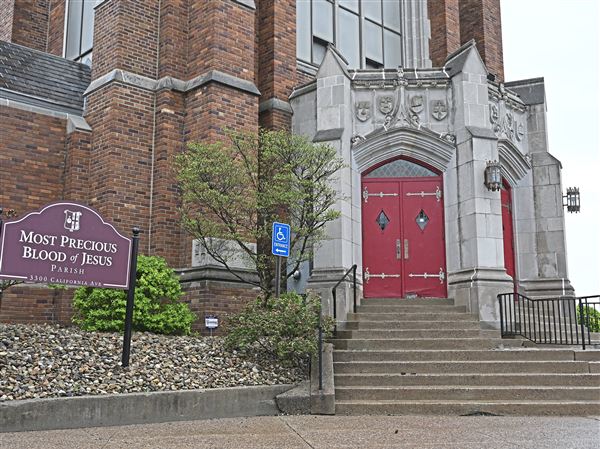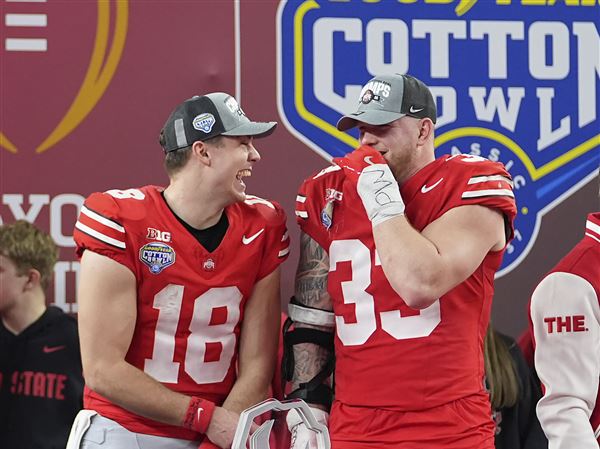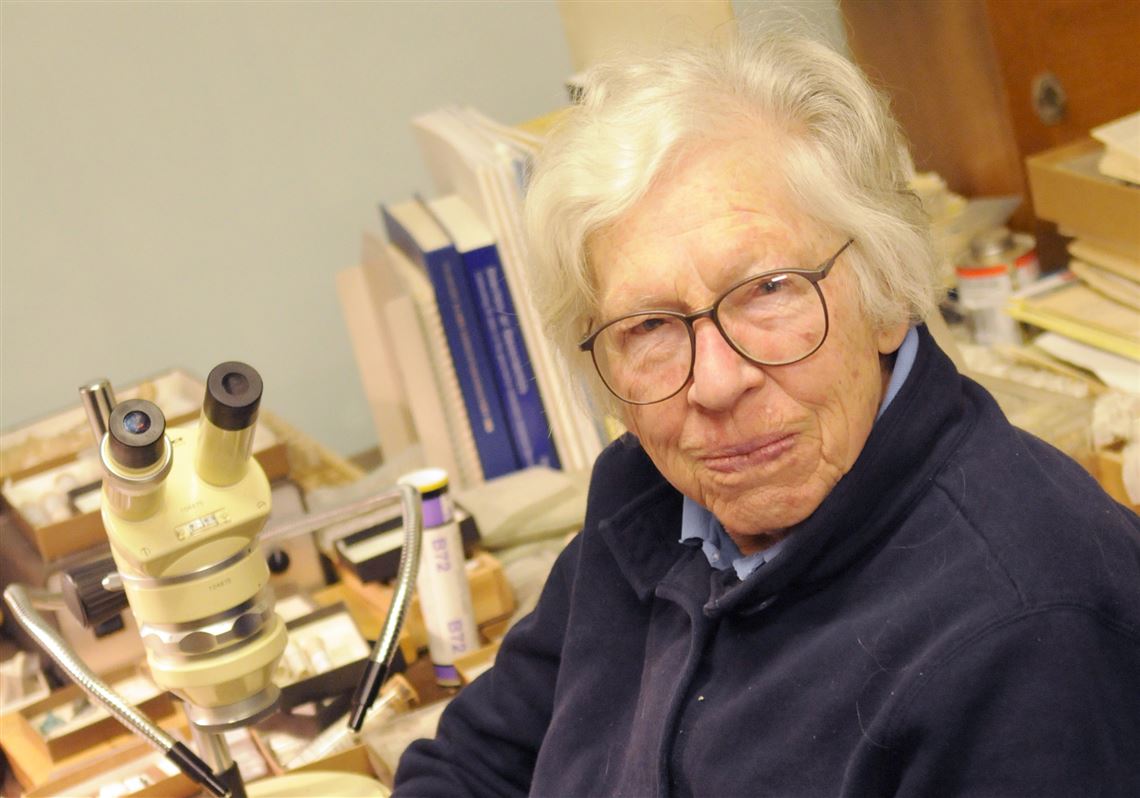For Mary R. Dawson, happiness could be found tucked away in the next cave or buried knee-deep in a mound of mud and rock.
Either way, as long as she was unearthing fossils and making discoveries, the longtime curator, author and researcher at the Carnegie Museum of Natural History could call it a good day.
Ms. Dawson was a trailblazer who shattered the glass ceiling in her field as an award-winning, “indefatigable” vertebrate paleontologist at the museum, where she oversaw the fourth largest vertebrate fossil collection in North America.
Ms. Dawson, who lived in a 19th century house on a sheep farm in Middlesex, Butler County, died of congestive heart failure Nov. 29. She was 89.
Her loss will be felt deeply in the scientific community, said a friend and colleague, Matthew C. Lamanna, who currently occupies the endowed curatorship established in Ms. Dawson’s honor at the museum.
“We in vertebrate paleontology… and indeed, people throughout the Carnegie Museums and paleontological communities as a whole, are brokenhearted over Mary Dawson’s passing,” he said. “She was the matriarch of vertebrate paleontology at our museum, working tirelessly to bring our department’s research program out of decades of doldrums beginning when she arrived here in the early 1960s.
“She was a pioneer of polar paleontology who uncovered crucial evidence of dramatic climate change in the distant past, such as fossils of alligators that inhabited the Arctic Circle roughly 50 million years ago. Indeed, Mary was widely regarded as one of the world’s foremost paleontologists; up until her passing, she was a living legend in every sense of the term. But most importantly, despite her eminence, Mary was 100% ego-free – a humble, kind, friendly person with a passion for dogs, a love of fossils, and the kind of laugh that made everyone else laugh along with her.”
Ms. Dawson came to the museum in 1963 as a research associate. Her boss, then director M. Graham Netting, made it clear that as a woman, she shouldn’t expect to ever be promoted to head curator.
"Actually, he ended up making me curator 10 years later," she told the Post-Gazette in March 2000.
From 1973 to 1997, Ms. Dawson also chaired the museum’s Earth Sciences Division, and she was recognized as a curator emeritus after her 2003 retirement.
As a girl, Ms. Dawson moved around the Michigan peninsula often with her parents and two siblings. A lifelong lover of animals, she at first studied veterinary medicine at Michigan State University before changing her major to zoology.
After graduation, she was offered a Fulbright scholarship to study paleontology at the University of Edinburgh in Scotland, then headed to the University of Kansas, where she earned a doctorate in paleontology.
Throughout her higher education, Ms. Dawson was the only woman in her field of study.
"The only thing that bothered me was finding a field party I could go on," Ms. Dawson recalled in the 2000 PG story. "They didn't want women along, and I looked and looked and finally found one with a fellow who took his wife along. Isn't that disgusting? It annoyed me, but you go around those annoyances."
In the early years of her career, the scientific theory of plate tectonics was being validated, leading Ms. Dawson and some colleagues to explore the idea that fossils could be located along a possible land bridge between North America and Europe, in the Canadian Arctic.
During 11 field seasons in the Arctic Circle between 1973 and 2002, she made some surprising discoveries, including alligator teeth she found while kicking around the crunchy earth, searching for a place to eat her lunch of cheese and crackers with chocolate.
That discovery, among others, provided concrete evidence of a greenhouse effect 55 million years ago.
Ms. Dawson, whose research focused mainly on fossil remains of small mammals like rodents and rabbits, unearthed the first prehistoric mammals ever found in the Arctic, helping to prove the existence of a land bridge.
Her work also resolved some longtime mysteries, including why the fossils of horses, rhinoceroses and other mammals in North America so closely resembled those found in Europe.
Her time in the Arctic provided other forms of excitement that she could have done without, including a harrowing encounter with a pack of wolves in the summer of 1977.
According to “The Indefatigable Mary Dawson: Arctic Pioneer,” a tribute written in 2007 by Jaelyn J. Eberle and Malcolm C. McKenna, Ms. Dawson and a fellow scientist ran into a pack of six Arctic wolves while scaling a steep canyon near a fjord.
The wolves curiously approached as Ms. Dawson and her partner began flinging clumps of dirt at them. Undeterred, the female alpha wolf lunged at Ms. Dawson, according to the publication, which further detailed the encounter:
“[Ms. Dawson] leaned back, and with arms in front, let out a startled cry,” it said. “The wolf dropped to the ground, turned, and warily moved away, glancing back at [them] as they threw clods of silt at her and the other wolves. Although unhurt, [Ms. Dawson’s] brush with the lead wolf left traces of wolf saliva on her cheek.”
Ms. Dawson’s work was recognized with several prestigious awards, including the A.S. Romer - G.G. Simpson Medal, the highest honor bestowed by the Society of Vertebrate Paleontology. She was the first American woman to receive the award, in 2002, and the second woman to serve as SVP president, in 1973-1974.
Ms. Dawson’s other passion was dogs, especially Scottish deerhounds and Bernese mountain dogs, said her best friend Deborah Godfrey, of Penn, Butler County.
“She met her first Bernese mountain dog in 1957 while strolling in a park in Basel, Switzerland, and it was love at first sight,” Ms. Godfrey said.
Life won’t be the same without her dear friend, Ms. Godfrey said.
“How do you capture an extraordinary life in just a few words? You simply can’t,” she said. “For those of us who knew her, our life has been bolstered by such an exceptional woman. It is richer; it is forever changed.”
Ms. Dawson is survived by a brother, John, of Santa Fe, N.M.; a niece Karina Philpot, of Benbrook, Texas.; and a nephew, Patrick Dawson, of Las Cruces, N.M.
Her funeral was private.
Janice Crompton: jcrompton@post-gazette.com.
First Published: December 13, 2020, 12:00 p.m.

















